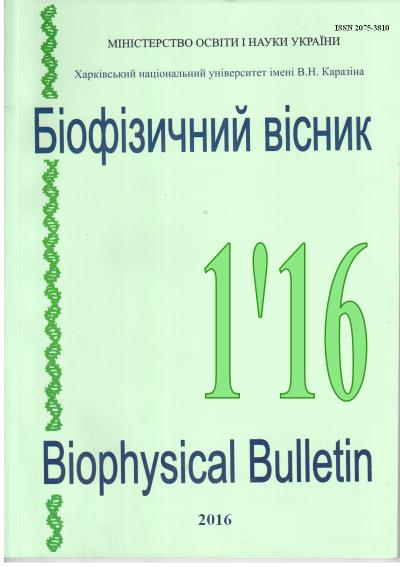Dielectric permittivity capable of vitrification cryoprotective media
Abstract
The research aim was to determine dielectric parameters and state of water in capable of vitrification media PVS2, 88% PVS3 and PVSN, the components of those are glycerol, dimethyl sulfoxide, ethylene glycol and non-penetrating cryoprotectant sucrose. These media are widely used to cryopreserve meristems, embryoids, callus, allowing the preservation of plant genetic resources under liquid nitrogen conditions for a long time period. Dielectric characteristics of the samples of cryoprotective media, their real ε′ and imaginary ε′′ components were measured at 20 °C using resonant type UHF-dielectrometer at 9.2 GHz frequency. The values of static dielectric permittivity εs of the media on the low-frequency side of the water relaxation and dielectric relaxation frequency of water molecules fd were counted using the Debye equations. It has been shown that the least values of dielectric parameters are characteristic for 88% cryoprotective medium PVS3, which comprises such cryoprotectants as glycerol and sucrose. This medium has the highest ability of binding and ordering the water. When determining the cytotoxicity and effect of low temperature storage on viability of potato, grape, garlic meristems all the studied cryoprotective media can be used when developing the efficient protocols of cryopreservation.
Downloads
References
Ekologіchna bezpeka derzhavi: materіali Vseukr. nauk. konf. stud. і asp., 21-24 kvіtnja 2009 r., Kiїv / Nac. avіac. un-t. - K., 2009. - 232 s.
Krіozberіgannja zrazkіv genofondu chasniku / T.І. Vіcenja, T.V. Іvchenko, T.F. Stribul', N.O. Shevchenko // Genetichnі resursi roslin. – 2010. – № 8. – S. 200-208.
Baudot A. Glass-forming tendency in the system water – dimethil sulfoxide / A. Baudot, L. Algel, P. Boutron // Cryobiology. – 2000. – V. 41, N 1. – P. 151-158.
Fahy G.M. Principles of cryopreservation by vitrification / G.M. Fahy, B. Wowk // Methods Mol Biol. – 2015. – Vol. 1257. – P. 21-82.
Volk G.M., Walters C. Plant vitrification solution 2 lowers water content and alters freezing behavior in shoot tips during cryoprotection / G.M. Volk, C. Walters // Cryobiology. – 2006. – V. 52. – Р. 48-61.
Sakai A. Development of cryopreservation techniques / A. Sakai // Cryopreservation of tropical plant germplasm. Current research progress and application. JIRCAS, Tsukuba & IPGRI. – Rome, 2000. – P. 1–7.
Keller E.R.J. Сryopreservation of Allium sativum L (Garlic) / E.R.J. Keller // Biotechnology in Agriculture and Forestry. – 2002. – V. 50. – P. 37–47.
Stribul T.F. Optimizing method for potato meristem vitrification / T.F. Stribul, N.A. Shevchenko, L.F. Rozanov // Problems of Cryobiology.–2005.– Vol. 15, N4.– P. 657–654.
Shevchenko N.A. Integrity of grape and potato meristems using rapid freezing regimens / N.A. Shevchenko // Problems of Cryobiology. – 2004. – №4. – P. 30–33.
Best B.P. Cryoprotectant toxicity: facts, issues, and questions / B.P. Best // Rejuvenation Research. – 2015. – V. 18 (5). – P. 422-436.
Improved vitrification solutions based on the predictability of vitrification solution toxicity / G.M. Fahy, B. Wowk, J. Wu, S. Paynter // Cryobiology. – 2004. – Vol. 48, 1. – P. 22-35.
Development of alternative plant vitrification solutions in droplet-vitrification procedures /H.H. Kim, Y.G. Lee, D.J. Shin [et al.] // Cryo Letters. – 2009. – V. 30 (5). – P. 320-334.
Cryopreservation of asparagus (Asparagus officinalis L.) embryogenic suspension cells and subsequent plant regeneration by vitrification / S. Nishizawa, A. Sakai, Y. Amano, T. Matsuzawa // Plant Science. – 1993. – V. 91, Iss. 1. – P. 67-73.
Musatova I.B. Phase transitions and vitrification in protective media for cryopreservation of plant meristems / I.B. Musatova, N.O. Shevchenko // Biofizika zhivoj kletki – 2014. – T. 10. – P. 129-130.
Murashige T. A revised medium for rapid growth and bioassays with tobacco tissue cultures / T. Murashige, F. Skoog // Physiol. Plant. – 1962. – V. 15. – P. 473–497.
SVCh-dijelektrometrija biotehnologicheskih zhidkostej / T. A. Zhiljakova, O. A. Gorobchenko, O. T. Nikolov, G. V. Golubnichaja. — Kiev: Naukova dumka, 2015. — 112 s.
Sadek H. Conductance of KIO3 in glycerol-water mixtures / H. Sadek, A.M. Haber, F.X. Khalil // Electrochim. Acta. – 1969. – V. 14 (11). – P. 1089-1096.
Authors who publish with this journal agree to the following terms:
- Authors retain copyright and grant the journal right of first publication with the work simultaneously licensed under a Creative Commons Attribution License that allows others to share the work with an acknowledgement of the work's authorship and initial publication in this journal.
- Authors are able to enter into separate, additional contractual arrangements for the non-exclusive distribution of the journal's published version of the work (e.g., post it to an institutional repository or publish it in a book), with an acknowledgement of its initial publication in this journal.
- Authors are permitted and encouraged to post their work online (e.g., in institutional repositories or on their website) prior to and during the submission process, as it can lead to productive exchanges, as well as earlier and greater citation of published work (See The Effect of Open Access).





